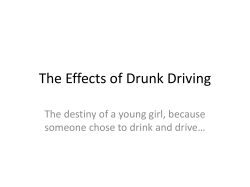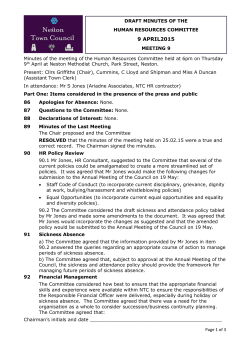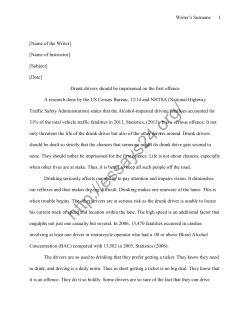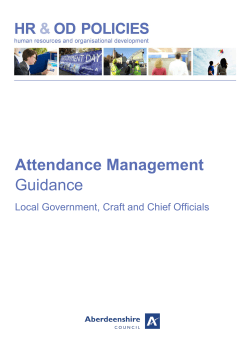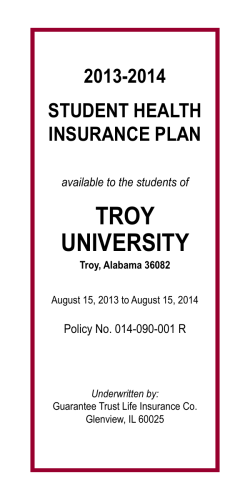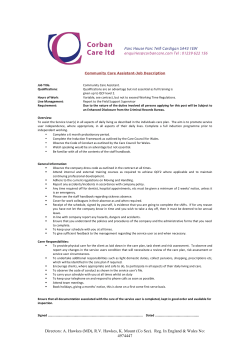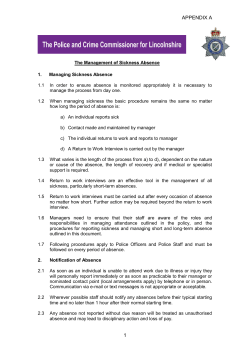
Sickness absence, article 3
Research on alcohol’s harm to others in Norway Inger Synnøve Moan, researcher/Phd Norwegian Institute for Alcohol and Drug Resarch (SIRUS) Seminar on Passive drinking, Tallinn March 30 Examples of harm to others Figure based on Ferris, Laslett et al. 2010 Employer/ colleagues - Sickness absence - Reduced efficiency - Production loss The user Family - Harm on fetus - Harm to children - Harm to partner or other family members, e.g., violence Others Friends - Loss of social network - Traffic injuries - Violence - Feeling insecure Selected research from Norway (2009 - ) • Four negative consequences of alcohol use: – – – – Sickness absence, 5 articles Drunk driving, 4 articles Harm to children, 1 article Violence, 1 article • Various methods: – Registry data – Longitudinal data – Self-report and oral fluid (Collaboration between the Norwegian Institute for Public Health & SIRUS) Approaches used to study sickness absence Article 1: Used registry data to examine whether an increase in the alcohol consumption on the population level leads to an increase in the prevalence of sickness absence Article 2 and 3: Alcohol and drug use last 24-48 hours mapped using oral fluid and questionnaires. In addition, self-reported sickness absence and reduced efficiency due to such use the past 12 months is mapped Article 4: Literature review of studies using individual-level data to examine the relationship between alcohol use and sickness absence Article 5: Invididual-level data are used to examine gender differences in the association between alcohol use and sickness absence self-reported to be alcohol-related, and to examine whether the prevention paradox applies to sickness absence and both genders Sickness absence, article 1 Norström, T. & Moan, I. S. (2009). Per capita alcohol consumption and sickness absence in Norway. European Journal of Public Health, 19 (4), 383-388. Aims: To determine whether an increase in per capita alcohol consumption of 1 litre per inhabitant have a significant impact on the sickness absence. Data and analyses: • Annually registered sickness absence and sales statistics for alcohol (inhabitants over 15 years) • Period: 1957-2001. • Box-Jenkins method for time series analyses. Sickness absence, article 1 Results: • An increase in the alcohol consumption of 1 litre per inhabitant led to a 13% increase in the sickness absence among men. • Consumption of spirits, not beer and wine, had a significant impact on sickness absence among men. • No significant effects among women o Three possible explanations: men drink more than woman, they more often drink to intoxication and they drink more spirits than woman do. Sickness absence, article 2 Gjerde, H., Christophersen, A. S., Moan, I. S., Yttredal, B, Normann, P. T., Mørland, J. & Walsh, J. M. (2010). Prevalence of alcohol and drugs at the workplace in Norway: A pilot study using questionnaires and analysis of oral fluid. Journal of Occupational Medicine and Toxicology, 5:13. Aims: 1. To map use of alcohol during the past 24 hours, and use of psychoactive medicinal drugs and illegal drugs during the past 48 hours 2. To map self-reported sickness absence and inefficiency at work due to alcohol and drugs during the past 12 months. Data: gathered using questionnaires (Q) and oral fluid (OF) during work hours among 526 respondents, 5 companies. Sickness absence, article 2 Results: • Alcohol: 4 % consumed 4 or more units of alcohol (OF and Q) vs. 1.9% (Q). • Psychoactive medicinal drugs: 5.1% (OF and Q) vs. 4.2% (Q) • Illegal drugs: 1.7 % (OF and Q) vs. 0.4% (Q). • 6% reported being absent from work due to alcohol use 1 or more times during the past 12 months • 24% ineffective while working due to hangover past 12 months Sickness absence, article 3 Edvardsen, H. M. E., Karinen, R. A., Moan, I. S., et al. (2014). Use of alcohol and drugs among health professionals in Norway: a study using data from questionnaires and samples of oral fluid. Journal of Occupational Medicine and Toxicology, 9. Aims (i) analyse samples of oral fluid and self-reported data from questionnaires to investigate the prevalence of alcohol and drugs among a sample of health professionals (HPs) in Norway (ii) study self-reported absence from or impairment at work due to alcohol and/or drug use Data and analyses: A total of 916 of the 933 invited HPs from hospitals and pharmacies participated in the study (participation rate = 98.2%), and 81.1 were women. Sickness absence, article 3 Results: • Alcohol, illicit drugs and medical drugs were found in 0.3, 0.6 and 7.3% of the samples, respectively. • Absence from work due to alcohol and medical drugs was reported by 0.9 and 0.8%, respectively. – Those who used medical drugs: 16.7% reported being absent from work due to such use the past 12 months and 25% reported inefficiency at work due to use of medical drugs. Sickness absence, article 4 Schou, L. & Moan, I. S. (2015). The alcohol use-sickness absence association and the moderating role of gender and socio-economic status: A literature review. Accepted for publication in Drug and Alcohol Review Aims: 1.To assess how well documented the association between alcohol use and sickness absence is 2.To examine whether type of measures of alcohol use and sickness absence influence the association 3.To examine whether the association is moderated by gender and socio-economic status Sickness absence, article 4 Method: • Review of individual-level studies specifically examining the alcohol use-sickness absence association – Published in peer-reviewed journals in English, dating from 1980 onwards – N = 28 studies, testing a total of 48 associations – Ten countries represented: USA (6), Australia (2), United Kingdom (4), Sweden (7), Norway (1), Denmark (1), Finland (4), The Netherlands (1), Japan (1) and Uruguay (1) – Four studies had a longitudinal design, the remaining were cross-sectional • The quality of the associations was evaluated, giving a score of 0-4 points, where 0-3 = low-medium and 4 = high quality. Sickness absence, article 4 Results: • High-quality associations: statistically significant in 100% of the cases. • Low-medium quality associations: alcohol use less consistently related to long-term than to short-term absence (singificant in 25% and 100% of the cases, respectively). • The association did not vary systematically across measures of alcohol use • The association applies to both genders and in all socio-economic strata, but in some instances more strongly in lower socioeconomic strata • Some support for a causal relationship, but more longitudinal studies are needed Sickness absence, article 5 Schou, L., Storvoll, E. E. & Moan, I. S. (2014). Alcohol-related sickness absence among young employees: Gender differences and the prevention paradox. European Journal of Public Health, 24 (3), 480-485. Aims were to examine: 1. gender differences in the prevalence of alcohol-related sickness absence among young employees in Norway, and in the association between drinking patterns and such absence, and 2. whether the prevention paradox applies to alcohol-related sickness absence among both genders Method and sample: • A sample of employed young adults, 49.7% male (N=1762, mean age =28.3) was obtained from a general population survey among Norwegians. • Self-reported measures of alcohol-related sickness absence and various drinking measures Sickness absence, article 5 Results: • Men reported alcohol-related absence nearly twice as often as women (10.5% vs 5.7%). • There was a statistically significant gender difference in the alcohol usesickness absence association for binge drinking, with a stronger association among woman. • The heaviest drinkers (6% of the sample) accounted for 19% of the sickness absence, yet the vast majority of the absence (81%) was found among moderate drinkers. – The prevention paradox applied to sickness absence among young employees, and among women and men – Implication: preventive efforts should be targeted against all employees, not only heavy drinkers Key findings sickness absence • When the total consumption of alcohol in the population increase, the prevalence of sickness absence increase • Literature review provide empirical support for an association between alcohol use and short- and long-term sickness absence – Applies to both genders and all socio-economic groups, but in some instances strongly in lower socio-economic groups • Self-reported sickness absence due to alcohol use past 12 months varies between 5-10% and about 25% report being less efficient at work at least once the past 12 months • The prevention paradox applies to sickness absence. – Implication: preventive efforts should be directed at all employees, not only heavy drinkers Approaches used to study drunk driving Article 1: Used registry data to examine whether an increase in the alcohol consumption on a population level leads to an increase in the prevalence of drunk driving Article 2. Used longitudinal data to examine how an increase in the frequency of heavy drinking episodes affects the incidents of drunk driving, and whether the effect of alcohol use on drunk driving is moderated by the personality trait impulsivity Article 3 and 4. Address the underlying factors of the motivation not to drink and drive/ not to ride with an intoxicated driver using a attitudebehaviour model, and examine whether this model applies differently for young and older drivers/passengers and among women and men Drunk driving, article 1 Norström, T. & Rossow, I. (2013). Population drinking and drink driving in Norway and Sweden: An analysis of historical data 19571989. Accepted for publication in Addiction. Aims: To estimate the relation between drunk driving and total consumption of alcohol on annual time-series data for Norway and Sweden. Data and analyses: • Drunk driving Norway: convictions for drunk driving per 100 000 inhabitants (aged 15-69 years). • Drunk driving proxy for Sweden: the proportion (%) of all policereported traffic accidents with personal injuries were the driver was under the influence of alcohol. • Proxy for total alcohol consumption: total alcohol sales in litres of pure alcohol per inhabitant (aged 15 years and older). • Time period: 1957-89. Drunk driving, article 1 Results: • The association between drunk driving and per capita alcohol consumption was strongly significant in Norway and Sweden. • For Norway, the estimated elasticity equalled 2 (p<.001) and for Sweden 1.5 (p<.001) – In other words: When the total alcohol consumption in Norway and Sweden increase so does the incidence of drunk driving Drunk driving, article 2 Moan, I. S., Norström, T. & Storvoll, E. E. (2013). Alcohol use and drunk driving: the modifying effect of impulsivity. Journal of Studies on Alcohol and Drugs, 74 (1), 114-119. Aims: 1. To examine how an increase in the frequency of heavy drinking episodes affects the incidence of drunk driving 2. To examine whether the effect of alcohol use on drunk driving is contingent on impulsivity. Data and analyses: • Young in Norway Longitudinal Study (N = 2,603; response rate: 67%) • 17 years (t1) and 28 years (t2) • Fixed effects (The first difference method). Drunk driving, article 2 Results: • Every additional episode of heavy drinking was associated with a 2.6% increase in the frequency of drunk driving. • Increase for males (3.4%) was significantly higher than among females (1.9%). • The alcohol use-drunk driving relation was twice as strong among those scoring high (3.4%) compared to those scoring low (1.6%) on impulsivity. Drunk driving, article 3 Moan, I. S. & Rise, J. (2011). Predicting intentions not to «drink and drive» using an extended version of the theory of planned behaviour. Accident Analysis and Prevention, 43, 1378-1384. Background • Most Norwegian licence holders consider driving with a BAC above the legal limit reprehensible (Vaas & Elvik, 1992) • 21-39% of Norwegians that are involved in fatal traffic accidents were influenced by alcohol (Brevig et al., 2004) • Factors besides attitude might influence behaviour in this context Drunk driving, article 3 Theoretical framework • Social psychologists have developed integrated attitude-behaviour models • The most well-known model is the Theory of Planned Behaviour (TPB) (Ajzen, 1991) • The TPB has good evidence for practicality (Fylan et al., 2006; Webb et al., 2010) and particularly predictive utility (Armitage & Conner, 2000) Drunk driving, Article 3 Theory of Planned Behaviour (TPB) Attitude Subjective norm Intention Behaviour PBC PBC = perceived behavioural control Additional predictors: • Descriptive norm • Moral norm Ajzen (1991) Drunk driving, article 3 Aims: (i) To determine to what extent the TPB components will predict intentions not to drink and drive (ii) whether descriptive norm and moral norm predict intentions, after accounting for the impact of the TPB components (iii)whether different processes influence the intention of women and men, and drivers aged 35 years and below versus drivers aged above 35 years Drunk driving, article 3 Method • Questionnaires were completed by 1025 respondents aged between 18-70 years • 46.6% men, average age was 43.9 years (SD = 13.5 years) • Analyses were conducted among those who had a drivers licence and who reported drinking at least 1-2 times per year (N = 879) Drunk driving, article 3 • The TPB accounted for a small proportion of the variance in intention in the sample as a whole (R2 = .10) • The contribution of descriptive norm and moral norm, beyond the TPB components, was small but significant (R2change = .02, p<.001) • The predictive utility of the specified model was better among: ○ young drivers than among drivers aged above 35 years (R2 = .26 versus .09) ○ male drivers than female drivers (R2 = .16 versus .05) Drunk driving, article 4 Moan, I. S. (2013). Whether or not to ride with an intoxicated driver: Predicting intentions using an extended version of the theory of planned behavior. Transportation Research Part F: Traffic Psychology and Behaviour, 20, 193–205. Background • Riding with an intoxicated driver increase the likelihood of being injured or killed in an accident • The likelihood of riding with an intoxicated driver increase with: o Low risk perception, social accept and low feeling of control o decreasing age and being male o Alcohol consumption • We know little about the relative impact of these predictors o Intergrated theoretical frameworks o Does these factors apply differently across age and gender Drunk driving, article 4 Aims 1. Determine to what extent the theory of planned behaviour (TPB) extended with moral norm, descriptive norm, demographic variables and frequency of alcohol use is able to predict intention not to ride with an intoxicated driver 2. Examine whether different processes guide intentions among young versus older passengers, and among women and men Method and respondents: 1025 respondents between 18 and 70 years completed the questionnaire, 44.9% were men. Drunk driving, article 4 Results: • The TPB variables explained 19% of the variance in intention, and the extension variables added another 5%. • The predictive utility of the specified model was better among: – Young passengers (R2 = .40) than among passengers aged above 35 years (R2 = .20) – Male (R2 = .27) than among female passengers (R2 = .17) Key findings drunk driving • When the total consumption of alcohol in the population increase, the prevalence of drunk driving increase • Men and individuals who are impulsive are more likely drive after episodes of heavy drinking • The predictive utility of the extended version of the theory of planned behaviour was better among young male passengers than among older female passengers – Useful theoretical approach when developing interventions for the most important target group in this context, i.e., young men Harm to children Harm to children Rossow, I. & Moan, I. S. (2012). Parental Intoxication and Adolescent Suicidal Behavior. Archives of Suicide Research, 16(1), 73-84 . Aims: 1. to determine the possible relationship between parental intoxication and suicidal behaviour among adolescents, 2. whether the association is stronger among younger adolescents and 3. whether intoxication among both parents as opposed to one parent matters. Data and analyses: • School surveys conducted in Norway in 2002 (N=11600) and 2004 (N=20700). • Students aged 13-19 years. Harm to children Results: • The more often adolescents witnessed their parents intoxicated, the greater was the share who reported thoughts about or attempts of suicide, also after controlling for their own drinking pattern. • Relationship significantly stronger among young than among older adolescents. • Whether the adolescents had witnessed one or both parents being intoxicated had no significant impact on the relationship. Violence Violence Norström, T. & Pape, H. (2010). Alcohol, suppressed anger and violence. Addiction, 105 (9): 1580-1586. Aim: To determine whether the relation between alcohol consumption and violence is moderated by suppressed anger. Data and analyses • Longitudinal study (N≈ 3000) • Self-report • 16-17 years (t1) and 21-22 years (t2) • Fixed effect (first difference method). Violence Results • Respondents who reported a strong tendency to suppress anger: a 10% increase in the episodes of intoxication led to a 5% increase in the incidence of violence. • Respondents not reporting such a tendency: no significant relationship. Summary of key findings • Empirical support for an assocation between alcohol use and four negative outcomes: – sickness absence, drunk driving, thoughts about or attempts of suicide among children and violence • When the total consumption of alcohol in the population increase, the prevalence of sickness absence and drunk driving increase • Literature review provide empirical evidence for an association between alcohol use and short- and long-term sickness absence • Prevalence of self-reported sickness absence due to alcohol use varies between 5-10% and about 25% report being less efficient at work at least once the past 12 months • The prevention paradox applies to sickness absence – Implication: preventive efforts should be directed at all employees, not only heavy drinkers • Personality moderate the association between alcohol use and negative outcomes, e.g. drunk driving and violence References Edvardsen, H. M. E., Karinen, R. Moan, I. S., Øiestad, E. L., Christophersen, A. S. & Gjerde, H. (2014). Use of alcohol and drugs among health professionals in Norway: a study using data from questionnaires and samples of oral fluid. Journal of Occupational Medicine and Toxicology, 9 (1). Gjerde, H., Christophersen, A. S., Moan, I. S., Yttredal, B, Normann, P. T., Mørland, J. & Walsh, J. M. (2010). Prevalence of alcohol and drugs at the workplace in Norway: A pilot study using questionnaires and analysis of oral fluid. Journal of Occupational Medicine and Toxicology, 5:13. Moan, I. S. (2013). Whether or not to ride with an intoxicated driver: predicting intentions using an extended version of the theory of planned behaviour. Submitted to Transportation Research Part F: Traffic Psychology and Behaviour, 20, 193-205. Moan, I. S., Norström, T. & Storvoll, E. E. (2013). Alcohol use and drunk driving: the modifying effect of impulsivity. Journal of Studies on Alcohol and Drugs, 74 (1), 114-119. Moan, I. S. & Rise, J. (2011). Predicting intentions not to «drink and drive» using an extended version of the theory of planned behaviour. Accident Analysis and Prevention, 43, 1378-1384. Norström, T. & Moan, I. S. (2009). Per capita alcohol consumption and sickness absence in Norway. European Journal of Public Health, 19 (4), 383-388. Norström, T. & Pape, H. (2010). Alcohol, suppressed anger and violence. Addiction, 105 (9): 15801586. Norström, T. & Rossow, I. (2013). Population drinking and drink driving in Norway and Sweden: An analysis of historical data 1957-1989. Accepted for publication in Addiction. Rossow, I. & Moan, I. S. (2012). Parental Intoxication and Adolescent Suicidal Behavior. Archives of Suicide Research, 16(1), 73-84 . Schou, L. & Moan, I. S. (2015). The alcohol use-sickness absence association and the moderating role of gender and socio-economic status: A literature review. Accepted for publication in Drug and Alcohol Review Schou, L., Storvoll, E. E. & Moan, I. S. (2014). Alcohol-related sickness absence among young employees: Gender differences and the prevention paradox. European Journal of Public Health, 24 (3), 480-485. Thank you for your attention! E-mail: [email protected]
© Copyright 2025
